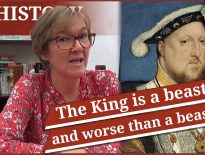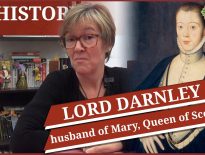On this day in Tudor history, 8th December 1542, Mary Stuart (Stewart), or Mary, Queen of Scots, was born at Linlithgow Palace in Scotland.
Mary was the daughter of King James V of Scotland and his second wife, Marie de Guise, and she became Queen of Scotland when she was just six days old.
Find out about the life of Mary, Queen of Scots, including her three marriages and abdication, her imprisonment and downfall in today's talk.
More talks on Mary, Queen of Scots:
Also on this day in history:
- 1538 – Death of Sir William Coffin, courtier and Master of the Horse to Queens Anne Boleyn and Jane Seymour, at Standon in Hertfordshire. It is thought that he died of the plague because his wife, Margaret, wrote to Cromwell saying that Coffin had “died of the great sickness, full of God's marks all over his body”. He was buried at the parish church in Standon.
- 1558 – Death of Hugh Weston, Dean of Windsor, at William Wynter's house in Fleet Street, London. He was buried at the Savoy. Weston had just been released from imprisonment in the Tower of London due to his ill health. He had been deprived of his deanery for alleged indecency in August 1557, and was arrested at Gravesend while he was on his way to Rome to appeal against his deprivation.
Transcript:
On this day in Tudor history, 8th December 1542, Mary Stewart (Stuart), or Mary, Queen of Scots, was born at Linlithgow Palace in Scotland.
Mary, Queen of Scots was the daughter of King James V of Scotland and his second wife, Marie de Guise. Her paternal grandparents were Margaret Tudor (King Henry VII’s eldest daughter) and King James IV of Scotland.
On the 14th December 1542, when she was just six days old, Mary became Queen of Scotland after her father died of a fever. She was crowned queen on 9th September 1543 at Stirling Castle. As Mary was only a baby, James Hamilton, 2nd Earl of Arran, acted as regent until 1554, when he surrendered the regency to Mary’s mother, Marie de Guise, who acted as regent until her death in 1560.
Mary was sent to France when she was just 5 years old, after a marriage between her and François, or Francis, the French Dauphin, had been agreed in a treaty in 1548. As the future queen consort of France, she received an excellent education and showed herself to be an excellent linguist. She married Francis, who was son of Henry II and Catherine de’ Medici, on the 24th April 1558 at Notre Dame Cathedral in Paris. She was 15 and her bridegroom was 14.
King Henry II of France died in July 1559, and Mary’s husband became Francis II of France. The couple already believed that they were King and Queen of England, Henry II having proclaimed them so after Queen Mary I’s death in 1558. Although Elizabeth I was Queen of England, many Catholics did not accept Elizabeth as Queen, because they believed her to be illegitimate, and believed that Mary Stuart was the true queen.
Francis II died on 5th December 1560, and Mary returned in August 1561 to her homeland of Scotland, a country divided by religious conflict. Although she was a staunch Catholic, she tolerated Protestants and had many Protestants on her Privy Council.
On the 29th July 1565, Mary married her second husband, Henry Stuart, Lord Darnley, at Holyrood Palace. As you will know from yesterday’s talk, although Mary did give birth to Darnley’s son, James, in June 1566, the marriage quickly soured and Darnley was murdered in February 1567. Mary went on to marry James Hepburn, 4th Earl of Bothwell, a man implicated in Darnley’s murder, after allegedly being abducted and raped by him in April 1567. The couple married at Holyrood on the 15th May 1567. The Scottish nobility did not approve of the match, and raised an army against Bothwell and Mary. Mary was imprisoned in Loch Leven Castle where, in July 1567, she miscarried twins. On the 24th July 1567 she was forced to abdicate, and her son by Darnley became King James VI of Scotland, with Mary’s illegitimate half brother, James Stewart, Earl of Moray, acting as Regent.
Mary managed to escape from Loch Leven on the 2nd May 1568, and fled to England where she was placed in protective custody in Carlisle Castle under the orders of Elizabeth I. She was to spend the rest of her life as a prisoner, being moved from Carlisle to Bolton Castle in July 1568, from Bolton to Tutbury Castle in January 1569, from Tutbury to Wingfield Manor, Chatsworth and Sheffield Castle and then back to Tutbury, from Tutbury to Chartley in December 1585, and finally to Fotheringhay Castle in 1586.
On her arrival in England in 1568, Mary had expected Elizabeth to support her in her endeavour to win back the throne of Scotland, but Elizabeth was unwilling to help a woman who was implicated in the murder of her second husband, Lord Darnley, and who refused to ratify the Treaty of Edinburgh. Mary was a threat to Elizabeth, as was shown by the Ridolfi Plot of 1570, a plot to assassinate Elizabeth and replace her with Mary. Mary denied any involvement in the plot, but was implicated in the Babington Plot of 1586 after Sir Francis Walsingham intercepted letters in which Mary gave her support for an attempt on Elizabeth I’s life. Mary was tried for treason in October 1586 and found guilty. Parliament and Elizabeth’s Privy Council put pressure on Elizabeth to execute Mary, but Elizabeth was unwilling to sign the death warrant of a fellow sovereign, who she believed to be appointed by God, and also a woman with Tudor blood. Elizabeth finally signed Mary’s death warrant on the 1st February 1587 and it was delivered, without the Queen’s knowledge to Fotheringhay, where the sentence was carried out on the 8th February 1587.
Mary was laid to rest originally at Peterborough Cathedral but was reinterred at Westminster Abbey after her son had become King of England.



Leave a Reply